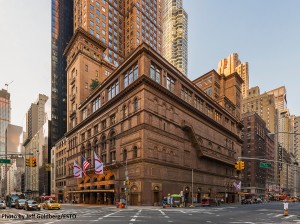Siemens helps Carnegie Hall achieve LEED Silver Certification from USGBC
New York, NY Siemens served as a technology partner for implementing building automation, fire safety and security solutions, helping to make Carnegie Hall more energy efficient, safe and secure. Carnegie Hall, the 125-year old NYC music venue, was awarded the Leadership in Energy and Environmental Design (LEED) Silver Certification from the U.S. Green Building Council, making it one of the oldest and most notable buildings to achieve such distinction. This milestone was achieved in part through a close collaboration with Siemens, which was enlisted as one of Carnegie Hall’s technology partners to modernize almost 165,000 s/f of non-performance space.
The certification came to fruition following the fall 2014 completion of Carnegie Hall’s Studio Towers Renovation Project (STRP), an infrastructure upgrade for two towers originally added atop the famed concert hall at the end of the 19th century.
A central focus of this comprehensive renovation was the addition of the new 60,000 s/f Resnick Education Wing, located on the Hall’s upper floors, as well as the refurbishment of the Hall’s backstage areas. In addition to its programmatic importance to the Hall, the project created an extraordinary opportunity to highlight the importance of sustainable design and its positive impact on New York City, providing an inspiring example of the adaptive reuse of a historic building.
“With the Studio Towers Renovation Project and creation of our new Resnick Education Wing, we aimed to build on Carnegie Hall’s amazing history, ensuring Siemens AG Communications and Government Affairs Head: Stephan Heimbach Wittelsbacherplatz 2 80333 Munich Germany Reference number: PR2015080302BTEN Siemens AG Press Release Reference number: PR2015080302BTEN Page 2/4 that our building continues to revitalize itself for the 21st century as a place as important to the future of music as it has been to the past,” said Clive Gillinson, Carnegie Hall’s Executive and Artistic Director. “An important component of the project has been the opportunity to upgrade our building’s infrastructure, and we are thrilled to say, as we approach our 125th anniversary, that Carnegie Hall is more energy-efficient and environmentally-friendly for staff and visitors than ever before.”
As part of the Studio Towers renovations, Siemens supplied building automation, fire and life safety, and security systems to make Carnegie Hall more energy efficient, safe and secure. Technology highlights include:
· Centralized control: Siemens Apogee building automation system integrates heating, venting, and air conditioning controls onto one platform that can be controlled both locally by end-users and from one central location by building engineers, or remotely, if desired. It also continually analyzes electricity demand and usage to manage overall building energy performance.
· Enhanced security: Siemens Sipass access control system addresses Carnegie Hall’s complex security needs by ensuring that only the right people have access to the right places at the right time. This is crucial, as Carnegie Hall has various access points and levels of clearance for building staff, students, and performers, among others.
· Fire and life safety system: Siemens XLS Fire Alarm Systems’ advanced technology allows Carnegie Hall to ensure the safety of its occupants. If a fire is detected, the command-and-control station is instantly alerted and emergency control operations are engaged, including fire door closure, elevator capture, and air handler turn-on/shut-off, among other critical functions.
“We are honored to have been involved in this project and help Carnegie Hall to achieve its vision of providing a music learning space for students, families, young artists, and people from across New York City,” said Dave Hopping, President of Siemens’ North American-based Building Technologies Division. “It was a challenge retrofitting a nearly 125-year old building that had no original blue prints with technology that would modernize its energy efficiency, fire and safety systems, but Siemens AG Press Release Reference number: PR2015080302BTEN Page 3/4 as a result of these efforts, Carnegie Hall is now one of the oldest buildings to receive a LEED Silver Leadership certification.”
An additional component of the overall project that helped Carnegie Hall achieve its LEED certification is a new 10,000-square-foot roof terrace with reflective pavers and plantings that reduce the heat island effect and the building’s overall carbon footprint. Thanks to the Hall’s 450 original windows on its upper floors, natural light has been maximized in the building’s renovation and design, which also incorporates the use of LED bulbs and occupancy sensors. Within the facility, lowflow plumbing fixtures also reduce the building’s water consumption. The Carnegie Hall project stands out as one of the most notable building technology and energy efficiency projects Siemens has ever completed. To date, Siemens technology has played a role in hundreds of buildings achieving LEED certification in the U.S.
IREON Insights: DURA Architectural Signage manufactures and delivers over one million signs









.gif)


.jpg)
.gif)